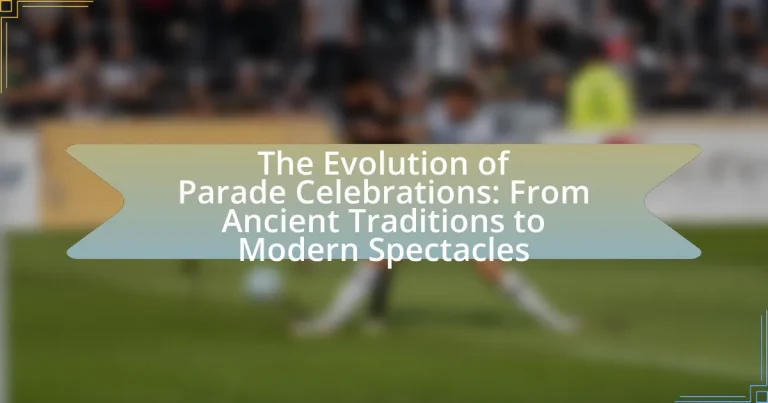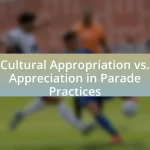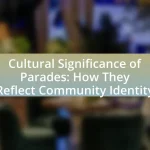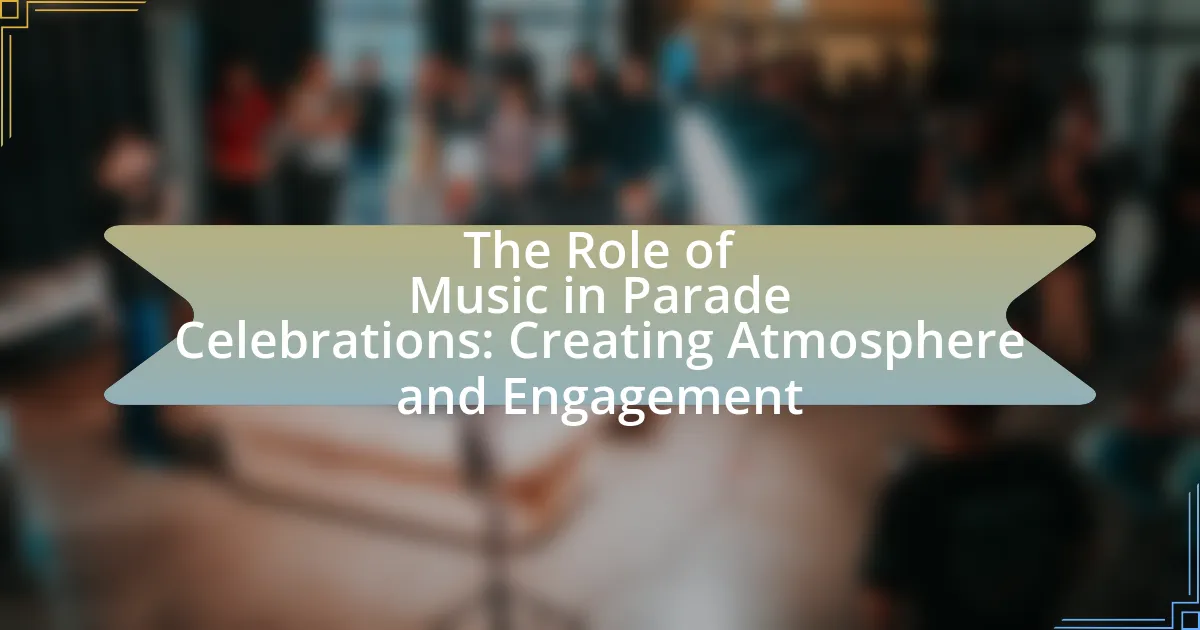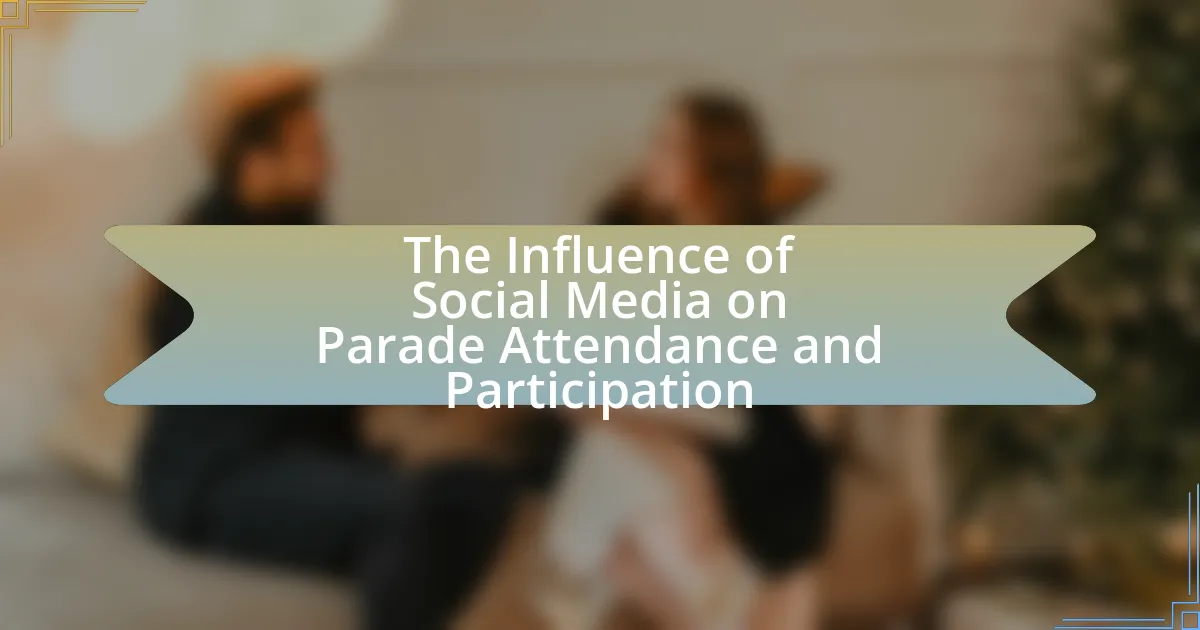The article examines the evolution of parade celebrations, tracing their historical significance from ancient rituals to modern public spectacles. It highlights how parades have served various purposes, including religious observances, military victories, and cultural festivals, fostering community spirit and social cohesion. Key sections explore the role of parades in ancient cultures, their transformation during the Middle Ages and the Industrial Revolution, and their contemporary significance in promoting cultural diversity and inclusivity. Additionally, the article discusses best practices for organizing successful parades, emphasizing community involvement and safety measures.
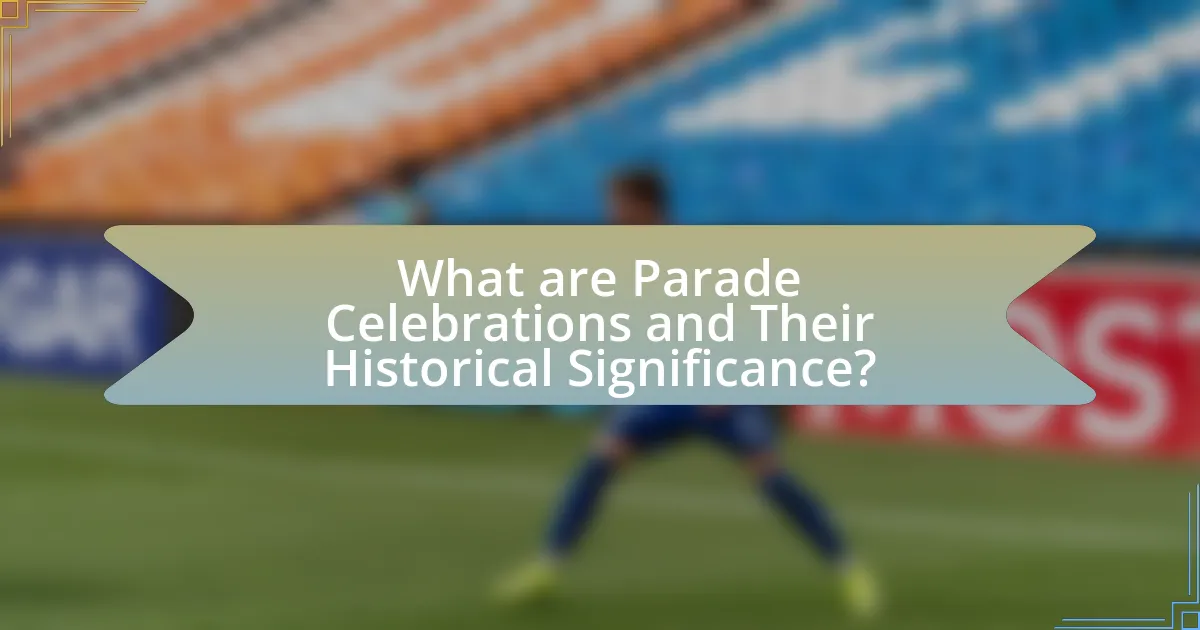
What are Parade Celebrations and Their Historical Significance?
Parade celebrations are organized public events featuring a procession of people, vehicles, and floats, often accompanied by music and performances. Historically, these celebrations have served various purposes, including religious observances, military victories, and cultural festivals, reflecting the values and traditions of societies. For instance, ancient Roman triumphs celebrated military conquests, while modern parades, such as Mardi Gras in New Orleans, showcase cultural heritage and community spirit. The significance of parades lies in their ability to unite communities, commemorate historical events, and express cultural identity, making them a vital aspect of social cohesion throughout history.
How did ancient cultures celebrate with parades?
Ancient cultures celebrated with parades as a means to honor deities, commemorate significant events, and foster community spirit. For instance, the ancient Greeks held processions during festivals like the Panathenaea, which included music, dance, and offerings to Athena, showcasing their devotion and unity. Similarly, the Romans celebrated triumphal parades to honor military victories, featuring soldiers, captives, and elaborate floats, which served to reinforce the power of the state and its leaders. These parades were not only festive occasions but also served as public displays of cultural identity and social cohesion.
What rituals and traditions were associated with early parades?
Early parades were associated with rituals and traditions that included religious ceremonies, military displays, and seasonal celebrations. These parades often served to honor deities, commemorate victories, or mark agricultural cycles, reflecting the cultural values of the societies that organized them. For instance, ancient Roman parades, known as “triumphs,” celebrated military conquests and involved elaborate processions featuring soldiers, captives, and offerings to the gods, demonstrating the importance of military success in Roman culture. Similarly, harvest festivals in various ancient civilizations included parades to give thanks for bountiful crops, showcasing the community’s agricultural achievements and reinforcing social cohesion.
How did parades serve as a means of social cohesion in ancient societies?
Parades served as a means of social cohesion in ancient societies by bringing communities together to celebrate shared values, beliefs, and cultural identity. These public displays often involved rituals, music, and collective participation, reinforcing social bonds among participants. For instance, in ancient Rome, parades were held to honor military victories, which not only celebrated the achievements of the state but also fostered a sense of unity and pride among citizens. Such events allowed individuals to engage in communal experiences, thereby strengthening interpersonal relationships and societal ties.
What role did parades play in historical events?
Parades have historically served as significant public displays that symbolize national pride, cultural identity, and social cohesion. They have played crucial roles in various historical events, such as military victories, national holidays, and social movements, by uniting communities and fostering a sense of belonging. For instance, the victory parades following World War II celebrated the end of conflict and honored military personnel, reinforcing national unity and collective memory. Additionally, parades like the Stonewall Riots in 1969 became pivotal in the LGBTQ+ rights movement, transforming into annual pride parades that advocate for equality and visibility. These examples illustrate how parades have functioned as powerful tools for expression, celebration, and social change throughout history.
How have parades been used to commemorate significant historical milestones?
Parades have been utilized to commemorate significant historical milestones by serving as public displays of collective memory and national pride. For instance, the Macy’s Thanksgiving Day Parade in the United States celebrates the holiday’s cultural significance while also marking the onset of the Christmas season, reflecting societal values and traditions. Similarly, military parades, such as those held on Bastille Day in France, commemorate the French Revolution and symbolize national unity and strength. These events often feature elaborate floats, performances, and community participation, reinforcing the historical importance of the milestones they celebrate. Historical records indicate that parades have been a part of human culture for centuries, with ancient civilizations, such as the Romans, using them to honor military victories and significant events, thereby establishing a long-standing tradition of public commemoration through parades.
What impact did military parades have on national identity?
Military parades significantly reinforce national identity by showcasing a nation’s military strength and unity. These events serve as a public display of patriotism, often invoking national pride and collective memory among citizens. For instance, the annual Bastille Day parade in France not only commemorates the French Revolution but also symbolizes national resilience and unity, fostering a sense of belonging among the populace. Additionally, military parades often feature national symbols, such as flags and anthems, which further solidify the connection between the military and national identity. Historical examples, like the Soviet Union’s Red Square parades, illustrate how such displays were used to project power and instill national pride during the Cold War era.
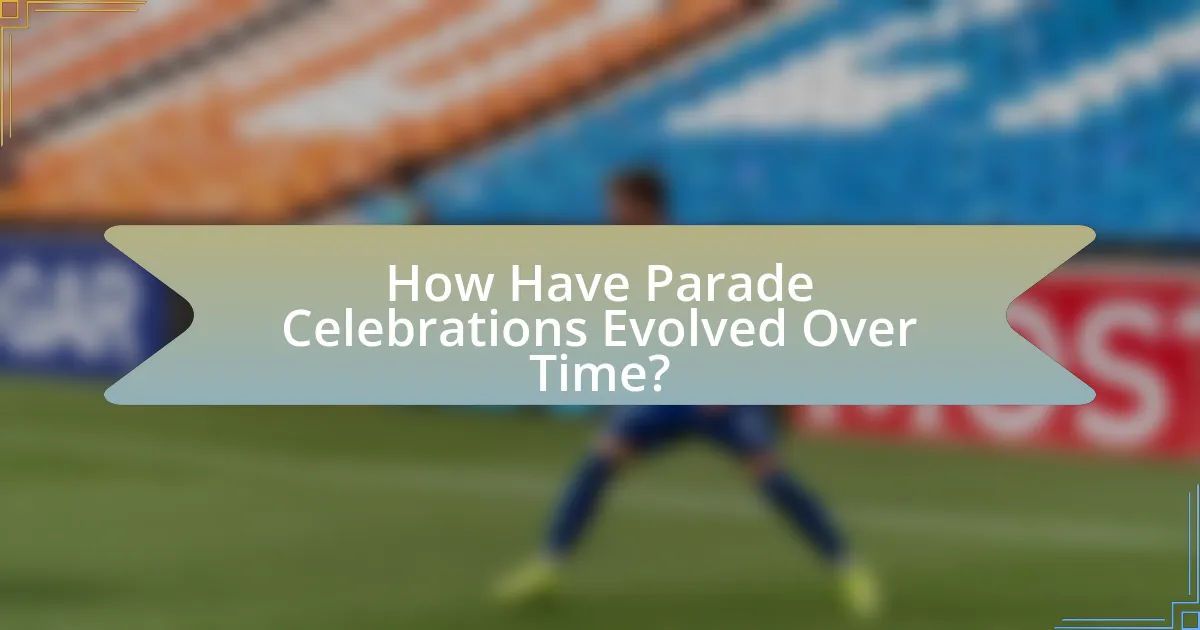
How Have Parade Celebrations Evolved Over Time?
Parade celebrations have evolved from ancient rituals and religious observances into large-scale public spectacles that reflect cultural, social, and political themes. Initially, parades served as processions to honor deities or commemorate significant events, as seen in ancient Rome and Greece, where military victories were celebrated with grand displays. Over time, particularly from the 19th century onward, parades began to incorporate elements of entertainment, community participation, and commercial interests, exemplified by events like Mardi Gras and Thanksgiving parades in the United States. This transformation has led to the inclusion of diverse cultural expressions, elaborate floats, and performances, making modern parades a platform for social movements and community identity, as evidenced by events like Pride parades and political marches.
What changes occurred in parade celebrations during the Middle Ages?
During the Middle Ages, parade celebrations evolved significantly, shifting from primarily religious and seasonal observances to more civic and military displays. Initially, parades were closely tied to religious festivals, showcasing processions that honored saints and marked important liturgical events. However, as feudalism strengthened, parades began to incorporate elements of local governance and military power, reflecting the growing influence of monarchs and nobility.
For instance, the coronation ceremonies of kings often included grand parades that displayed the ruler’s authority and the loyalty of their subjects. Additionally, the rise of towns and cities led to civic parades that celebrated local patron saints and community achievements, further diversifying the nature of these events. The incorporation of pageantry, such as floats and elaborate costumes, became more pronounced, emphasizing both the social hierarchy and the collective identity of communities.
These changes illustrate a transition in parade celebrations from purely religious contexts to multifaceted events that served political, social, and cultural purposes, marking a significant evolution in their role within medieval society.
How did religious influences shape parades in medieval times?
Religious influences significantly shaped parades in medieval times by integrating religious themes, rituals, and processions into public celebrations. These parades often commemorated saints, religious events, and liturgical seasons, reflecting the central role of the Church in daily life. For instance, the Feast of Corpus Christi featured elaborate processions that included the display of the Eucharist, showcasing the importance of the sacrament in medieval Christianity. Additionally, many parades served as a means of reinforcing community identity and social order, as they were often sanctioned by local authorities and organized by religious institutions. This intertwining of faith and festivity illustrates how religious beliefs directly influenced the structure, purpose, and content of parades during this period.
What were the characteristics of royal processions during this period?
Royal processions during this period were characterized by elaborate displays of wealth, power, and ceremonial significance. These processions typically featured ornate carriages, richly adorned participants, and a carefully orchestrated sequence of events that highlighted the status of the monarchy. Historical records indicate that such processions often included military units, musicians, and representatives from various social classes, reinforcing the hierarchical structure of society. The use of vibrant colors, intricate costumes, and symbolic elements, such as banners and heraldry, served to enhance the visual impact and cultural importance of these events.
How did the Industrial Revolution impact parade celebrations?
The Industrial Revolution significantly transformed parade celebrations by introducing mechanization and urbanization, which allowed for larger and more elaborate events. The rise of factories and mass production enabled the creation of intricate floats and costumes, enhancing the visual spectacle of parades. Additionally, the growth of cities provided a centralized location for these celebrations, attracting larger crowds and fostering community engagement. Historical records indicate that parades became more organized and frequent during this period, reflecting the social and cultural changes brought about by industrialization.
What innovations in technology influenced the scale and spectacle of parades?
Innovations in technology such as advancements in sound systems, lighting, and float design have significantly influenced the scale and spectacle of parades. High-quality sound systems allow for synchronized music and announcements, enhancing the overall experience for spectators. Modern lighting technology, including LED displays, enables vibrant visual effects that can transform floats and performances, making them more captivating. Additionally, innovations in float design, including the use of hydraulics and lightweight materials, have allowed for larger and more elaborate structures, contributing to the grandeur of parades. These technological advancements have collectively elevated the visual and auditory impact of parades, making them more engaging and memorable for audiences.
How did urbanization change the nature of public celebrations?
Urbanization transformed public celebrations by shifting them from localized, community-based events to large-scale, organized spectacles that reflect urban diversity. As cities grew, celebrations began to incorporate more elaborate parades, performances, and public displays, often funded and organized by municipal authorities or corporations. This change is evident in the rise of events like Mardi Gras in New Orleans and the Macy’s Thanksgiving Day Parade in New York City, which showcase the cultural amalgamation and commercial interests of urban environments. The increased population density and mobility in cities facilitated greater participation and visibility, making public celebrations more inclusive yet also more commercialized.
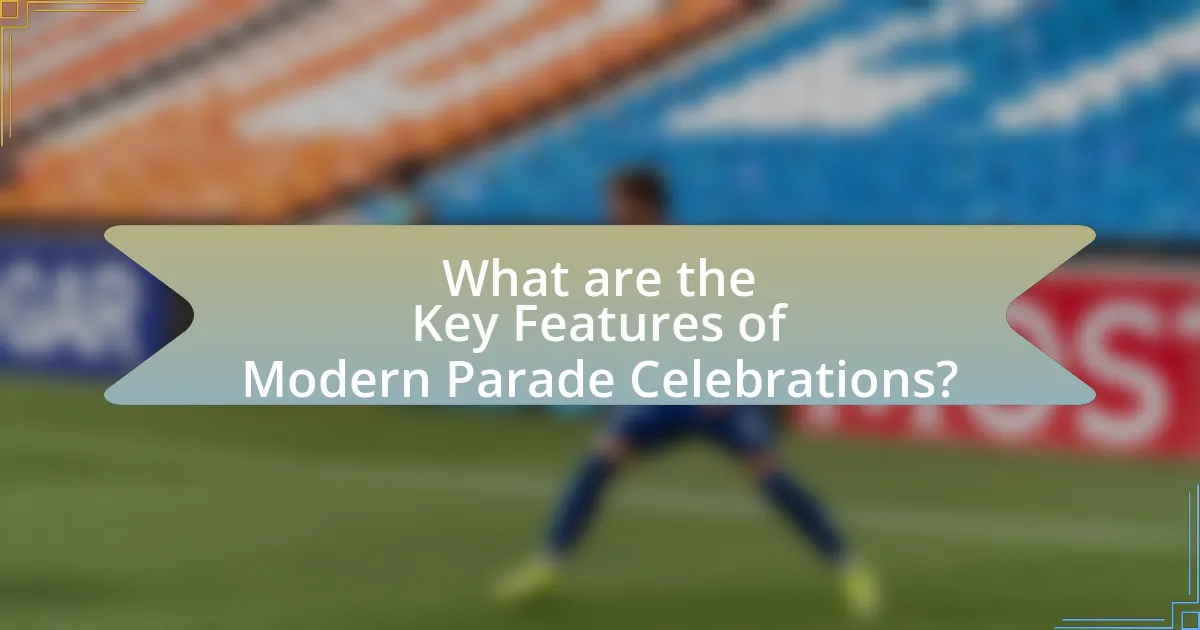
What are the Key Features of Modern Parade Celebrations?
Modern parade celebrations are characterized by vibrant floats, diverse cultural representations, elaborate costumes, and live performances. These elements create a visually engaging experience that reflects community identity and heritage. For instance, major events like the Macy’s Thanksgiving Day Parade feature large character balloons and musical performances, attracting millions of viewers annually. Additionally, modern parades often incorporate technology, such as live streaming and social media engagement, enhancing audience interaction and reach. These features collectively contribute to the festive atmosphere and cultural significance of contemporary parades.
How do modern parades reflect cultural diversity?
Modern parades reflect cultural diversity by showcasing a variety of cultural expressions, traditions, and identities through music, dance, costumes, and floats. These events often feature participants from different ethnic backgrounds, highlighting their unique customs and heritage, which fosters inclusivity and community engagement. For instance, the New York City Pride Parade celebrates LGBTQ+ culture alongside various ethnic groups, demonstrating the intersectionality of identities. Additionally, events like the Carnival in Rio de Janeiro incorporate African, Indigenous, and European influences, illustrating Brazil’s multicultural fabric. Such parades serve as platforms for cultural exchange and awareness, reinforcing the importance of diversity in contemporary society.
What types of cultural expressions are showcased in contemporary parades?
Contemporary parades showcase a variety of cultural expressions, including traditional music and dance, visual arts through floats and costumes, and community storytelling. These elements reflect the diverse heritage and identities of the participants, often incorporating local customs, historical narratives, and contemporary social themes. For instance, parades like the Rio Carnival prominently feature samba music and dance, while pride parades celebrate LGBTQ+ identities through vibrant displays and performances. This blend of artistic forms serves to engage audiences and foster a sense of community, highlighting the significance of cultural representation in public celebrations.
How do parades promote inclusivity and community engagement today?
Parades promote inclusivity and community engagement today by serving as platforms for diverse groups to showcase their cultures and identities. These events encourage participation from various demographics, fostering a sense of belonging and unity among attendees. For instance, pride parades celebrate LGBTQ+ identities, while cultural festivals highlight the traditions of different ethnic communities, allowing individuals to express themselves openly. Research indicates that such gatherings can enhance social cohesion, as they bring together people from different backgrounds, creating opportunities for dialogue and understanding. According to a study published in the Journal of Community Psychology, community events like parades significantly increase social capital, which is essential for building inclusive communities.
What are the most famous modern parades around the world?
The most famous modern parades around the world include the Macy’s Thanksgiving Day Parade in New York City, the Carnival in Rio de Janeiro, the Rose Parade in Pasadena, and the Notting Hill Carnival in London. The Macy’s Thanksgiving Day Parade, held annually since 1924, features large balloons and floats, attracting millions of spectators. The Carnival in Rio de Janeiro, celebrated for its vibrant samba parades, draws over two million people daily during the festival. The Rose Parade, known for its elaborate floral floats, has been a New Year’s Day tradition since 1890. The Notting Hill Carnival, celebrating Caribbean culture, is one of the largest street festivals in Europe, attracting around two million attendees each year. These parades exemplify cultural significance and community engagement, making them iconic events globally.
What unique elements define events like the Macy’s Thanksgiving Day Parade?
The unique elements that define events like the Macy’s Thanksgiving Day Parade include large-scale floats, giant character balloons, live performances, and a festive atmosphere. The parade features elaborate floats designed by various organizations, showcasing creativity and artistry, while the iconic giant balloons, such as those shaped like popular cartoon characters, have become a hallmark since their introduction in 1927. Live performances from Broadway shows and musical acts contribute to the entertainment value, attracting millions of viewers both in person and through televised broadcasts. The event also emphasizes community spirit and tradition, as it has been celebrated annually since 1924, making it a significant cultural event in American society.
How do international parades, such as Carnival, differ from local celebrations?
International parades, such as Carnival, differ from local celebrations primarily in their scale and cultural significance. International parades attract global participation and media attention, showcasing diverse cultural expressions, elaborate floats, and performances that often reflect a blend of traditions from various regions. For instance, the Rio Carnival features samba schools competing with intricate costumes and large-scale parades, drawing millions of spectators and participants from around the world. In contrast, local celebrations tend to focus on community engagement, featuring smaller-scale events that highlight regional customs, local music, and traditional foods, often with a more intimate atmosphere. This distinction is evident in the way international parades serve as platforms for cultural exchange and tourism, while local celebrations emphasize community identity and heritage.
What are the best practices for organizing a successful parade celebration?
The best practices for organizing a successful parade celebration include thorough planning, community involvement, and effective communication. Thorough planning involves establishing a clear timeline, securing necessary permits, and coordinating logistics such as route mapping and safety measures. Community involvement ensures diverse participation, fostering a sense of ownership and excitement among local residents. Effective communication with participants, vendors, and the public is crucial for disseminating information about the event, including schedules and safety protocols. These practices are supported by successful examples, such as the Macy’s Thanksgiving Day Parade, which relies on meticulous organization and community engagement to attract millions of viewers annually.
How can organizers ensure safety and accessibility for all participants?
Organizers can ensure safety and accessibility for all participants by implementing comprehensive risk assessments and inclusive planning strategies. Conducting risk assessments identifies potential hazards and allows organizers to develop safety protocols, such as crowd control measures and emergency response plans. Additionally, incorporating accessibility features, such as wheelchair ramps, designated viewing areas, and accessible restrooms, ensures that individuals with disabilities can participate fully. According to the Americans with Disabilities Act, events must provide equal access to all attendees, reinforcing the importance of these measures.
What strategies can be employed to enhance community involvement in parades?
To enhance community involvement in parades, organizers can implement strategies such as engaging local schools, businesses, and community groups in the planning and execution of the event. By involving schools, students can participate through performances, floats, or volunteer roles, fostering a sense of ownership and pride. Collaborating with local businesses can lead to sponsorship opportunities and promotional activities that encourage community attendance. Additionally, creating volunteer programs allows residents to contribute their time and skills, further deepening their connection to the event. Research indicates that community-driven events see increased participation and satisfaction, as evidenced by studies showing that parades with local involvement attract larger crowds and foster community spirit.
